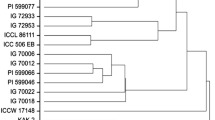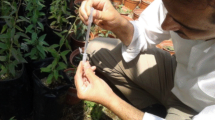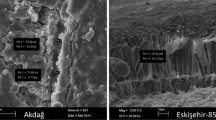Abstract
Fifteen okra germplasm entries viz. accessions: IC0506027, IC0506118 and EC0306728; Abelmoschus spp.: Abelmoschus tuberculatus, Abelmoschus moschatus, Abelmoschus angulosus, Abelmoschus tetraphyllus, Abelmoschus manihot and Abelmoschus caillei; genotypes: POL-6 and POL-7; and four cultivated varieties: Punjab 8, Punjab Padmini, Punjab 7 and Pusa Sawani were screened against jassid, Amrasca biguttula biguttula (Ishida) in field at Vegetable Research Farm, Department of Vegetable Science, Punjab Agricultural University, Ludhiana, India during Kharif 2015. Different morphological and biochemical parameters of leaves of the selected entries were also studied. The correlation between jassid nymphal population and mid vein hair density, total phenols and tannins was negative and significant (r = −0.67, −0.83, −0.75, respectively); negative and non-significant for hair length, angle of insertion of hair, total sugars and silica (r = −0.40, −0.49, −0.63 and −0.59, respectively) and positive and highly significant for lacination index, reducing sugars and lignins (r = 0.82, 0.95 and 0.90, respectively). Abelmoschus spp. Abelmoschus tetraphyllus, Abelmoschus angulosus and Abelmoschus moschatus were found to be field resistant on the basis of significantly lower pooled jassid nymphal population (1.56–1.99), jassid injury index (1.16–1.27) and susceptibility index (2.70–2.92). High degree of resistance in Abelmoschus tetraphyllus, Abelmoschus angulosus and Abelmoschus moschatus was found to be associated with high hair density (4.75–7.50), longer hair (1285.00–1513.20 μm), more erect hair (83.40–95.20°), broad leaves, high total sugars (15.21–18.36 mg/g), total phenols (1.52–1.58 mg/g), tannins (26.12–31.48 mg/g) and silica (32.66–33.17 mg/g) and low levels of reducing sugars (2.50–3.39 mg/g). Abelmoschus tuberculatus, A. manihot, IC0506027 and EC0306728 were found moderately field resistant with variable levels of morphological and biochemical parameters. High hair density, broad leaves, moderate levels of total sugars, reducing sugars, total phenols, tannins and silica seems to be associated with moderate levels of resistance in these entries. The variable levels of above mentioned parameters in moderately resistant entries also indicate that a single factor is not responsible for resistance but combination of different factors may be conferring resistance to jassid.


Similar content being viewed by others
References
Anitha, K. R., & Nandihalli, B. S. (2009). Evaluation of some okra hybrids against leafhopper and aphid. Karnataka Journal of Agricultural Sciemces, 22, 718–719.
Anonymous (2015a) National horticulture board (http://www.nhb.gov.in).
Anonymous (2015b) Package of practices for cultivation of vegetables, Punjab Agricultural University, Ludhiana (http://www.pau.edu).
Arumugam, R., & Muthukrishnan, C. R. (1977). An index describing the leaf shapes in okra. Indian Journal of Horticulture, 34, 257–259
Balasubramanian, G., & Gopalan, M. (1981). Role of carbohydrates and nitrogen in cotton varieties in relation to resistance to leafhopper. Indian Journal of Agricultural Science, 51, 795–798.
Bhat, M. G., Joshi, A. B., Mehta, S. L., & Singh, M. (1981). Biochemical basis of resistance to jassid in cotton. Crop Improvement, 8, 1–6.
Bindra, O. S., & Mahal, M. S. (1981). Varietal resistance in eggplant (brinjal), Solanum melongena to the cotton jassid, Amrasca biguttula biguttula. Phytoparasitica, 9, 119–131.
Bray, H. G., & Thorpe, W. V. (1954). Analysis of phenolic compounds of interest in metabolism. Methods of Biochemical Analysis, 1, 27–52.
Chakravorty, S. C., & Sahni, V. M. (1972). Biochemical basis of resistance to jassids (Empoasca spp.) in G. hirsutum cotton. Indian Agriculture, 16, 45–48.
Dhandapani, N., Shelkar, U. R., & Murugan, M. (2003). Bio-intensive pest management (BIPM) in major vegetable crops: an Indian perspective. Food Agriculture and Environment, 2, 333–339.
Dubois, M., Gilles, K. A., Hamilton, J. K., Robers, P. A., & Smith, F. (1956). Colorimetric method for determination of sugars and related substances. Analytical Chemistry, 26, 350.
Gangopadhyay A, Singh A, Bag M K and Dutta Mita (2016) Diversity analysis and evaluation of wild Abelmoschus species for agro-morphological traits and major biotic stresses under the north western agro-climatic condition of India. Genetic resources and crop evolution. Under Press.
Gonde, A. D., Kumar, A., Raut, A. H., Wargantiwar, R. K., & Phuke, D. P. (2013). Screening varieties of okra (Abelmoschus esculentus (Linnaeus) Moench) against important insect pests under agroclimatic conditions of Allahabad (UP). Trends in Biosciences, 6, 645–647.
Halder, J., Sanwal, S. K., Deb, D., Rai, A. B., & Singh, B. (2016). Mechanisms of physical and biochemical basis of resistance against leaf-hopper (Amrasca biguttula biguttula) in different okra (Abelmoschus esculentus) genotypes. Indian Journal of Agricultural Science, 86, 57–60.
Hooda, V. S., Dhankhar, B. S., & Singh, R. (1997). Evaluation of okra cultivars for field resistance to the leafhopper, Amrasca biguttula biguttula (Ishida). International Journal of Tropical Insect Science, 17, 323–327.
Iqbal, J., Hasan, M., Ashfaq, M., Shahbaz, T. S., & Amjad, A. (2008). Screening of okra genotypes against jassid, Amrasca biguttula biguttula (Ishida) (Homoptera: Cicadellidae). Pakistan Journal of Agricultural Sciences, 45, 448–451.
Iqbal, J., Hasan, M., Ashfaq, M., & Nadeem, M. (2011). Association of chemical components of okra with its resistance against Amrasca biguttula biguttula (Ishida). Pakistan Journal of Zoology, 43, 1141–1145.
Kochar S L (1986) Tropical crops. A text book of economic botany. Macmillan Indian Ltd. Pp. 263–264.
Mahal, M. S. (1973). Studies on varietal resistance in okra, Abelmoschus esculentus (Linnaeus) Moench and Brinjal, Solanum melongena (Linnaeus). MSc Thesis: Punjab Agricultural University, Ludhiana, India.
Muhammad, A., Muhammad, A., Waseem, A., Shahbaz, T. S., & Amzad, A. (2012). Physiomorphic characters of the brinjal, Solanum melongena (Linnaeus) plant and their relationship with the jassid (Amrasca biguttula biguttula) population fluctuation. Pakistan Journal of Agricultural Sciences, 49, 67–71.
Piper, C. S. (1950). Soil and plant analysis (pp. 258–275). New York: Interscience Publishers, Inc..
Prabu, T., Warade, S. D., Jatkar, M. A., & Baheti, H. S. (2009). Screening of okra germplasm against jassids, Amrasca biguttula biguttula (Ishida). Progressive Horticulture, 41, 30–35.
Raju, G. T. T., & Reddy, D. N. R. (1982). Screening of cotton varieties for their resistance against cotton jassid, Amrasca biguttula biguttula (Ishida) (Homoptera: Cicadellidae) 2. Biochemical basis of resistance. Cotton Development, 18, 39–42.
Rawat, R. R., & Sahu, H. R. (1973). Estimation of losses in growth and yield of okra due to Empoasca devastans (distant) and Earias spp. Indian Journal of Entomology, 35, 252–254.
Russell, L., & Bozzola, J. (1999). Electron microscopy (2 nd edition) (pp. 48–69). Toronto Canada: Jones and Bartlett Publishers.
Sandhu, G. S., Sharma, B. R., Singh, B., & Bhalla, J. S. (1974). Sources of resistance to jassid and whitefly in okra germplasm. Crop Improvement, 1, 77–81.
Sardana, H. R., & Dutta, O. P. (1989). Field response of okra (Abelmoschus esculentus) germplasm to infestation by shoot and fruit borer. Indian Journal of Agricultural Science, 59, 391–392.
Schanderl, S. H. (1970). Methods in food analysis (p. 709). New York: Academic Press.
Sharma, H. C., & Agarwal, R. A. (1983). Role of some chemical components and leaf hairs in varietal resistance in cotton to jassid, Amrasca biguttula biguttula (Ishida). Journal of Entomological Research, 7, 145–149.
Shinde, B. A., Gurve, S. S., Gonde, A. D., & Hole, U. B. (2014). Studies on resistance of cotton genotypes against jassids (Amrasca biguttula biguttula) Ishida. Bioinfolet, 11, 758–762.
Simmonds, M. S. J. (2003). Flavonoid-insect interactions: recent advances in our knowledge. Phytochemistry, 64, 21–30.
Singh, R. (1988). Basis of resistance in okra (Abelmoschus esculentus) to Amrasca biguttula biguttula. Indian Journal of Agricultural Sciences, 58, 15–19.
Singh, R., & Agarwal, R. A. (1988). Role of chemical components of resistant and susceptible genotypes of cotton and okra in ovipositional preference of cotton leafhopper. Proceedings of the Indian Academy of Sciences (Animal Sciences), 97, 545–550.
Singh, R., & Joshi, A. K. (2004). Pests of okra (Abelmoschus esculentus (Linnaeus) Moench) in Paonta Valley, Himachal Pradesh. Insect Environment, 9, 173–174.
Singh, L., & Singh, R. (2005). Influence of leaf vein morphology in okra genotypes (Malvaceae) on the oviposition of the leafhopper species, Amrasca biguttula (Hemiptera: Ciacadellidae). Entomologia Generalis, 28, 103–114.
Singh, T. H., Singh, G., Sharma, K. P., & Gupta, S. P. (1972). Resistance of cotton, Gossypium hirsutum (Linnaeus) to cotton jassid, Amrasca devastans (distant) (Homoptera: Jassidae). Indian Journal of Agricultural Science, 42, 421–425.
Singh, B., Rai, M., Kalloo, G., Satpathy, S., & Pandey, K. K. (2007). Wild taxa of okra (Abelmoschus species): Reservoir of genes for resistance to biotic stresses. Acta Horticulture, 752, 323–328.
Singh B, Sanwal S K, Venkataravanappa V & Halder J (2013) Breeding strategies for biotic stresses of okra: prospects and potential. National symposium on abiotic and biotic stress management in vegetable crops. Indian Institute of Vegetable Research, Varanasi.
Singh, P., Chauhan, V., Brahm Kumar, B. T., Chauhan, S. S., Simon, S., Bilal, S., & Abidi, A. B. (2014). An overview on okra (Abelmoschus esculentus) and its importance as a nutritive vegetable in the world. International Journal of Pharmacy and Biological Sciences, 4, 227–233.
Somogyi, M. (1952). Notes on sugar determination. The Journal of Biological Chemistry, 200, 245.
Stafford, H. A. (1960). Differences between lignin like polymers formed by peroxidation of eugenol and ferulic acid in leaf sections of Phleum. Plant Physiology, 35, 108–114.
Taylo L D & Bernardo E N (1995) Morphological and biochemical bases of resistance of eggplant (Solanum melongena (Linnaeus) and okra (Abelmoschus esculentus (Linnaeus) Moench.) to cotton leaf hopper (Amrasca biguttula Ishida). Pest management Council of the Philippines, Inc., College, Laguna (Philippines). PMCP 26th Anniversary Annual Science Meeting.
Ullah, S., Javed, H., & Aziz, M. A. (2012). Role of physico-morphic characters of different okra genotypes in relation to population of Jassid, Amrasca biguttula biguttula Ishida. Journal of Agricultural Research, 50, 217–224.
Acknowledgements
We are thankful to Dr. Anu Kalia, Assistant Professor (Nanoscience), PAU, Ludhiana for her guidance in taking SEM micrographs in her lab and also to Dr. Vijay Kumar, Senior Entomologist, and Dr. K S Suri, Senior Entomologist, Department of Entomology, PAU, Ludhiana for their critical discussions and suggestions.
Author information
Authors and Affiliations
Corresponding author
Rights and permissions
About this article
Cite this article
Sandhi, R.K., Sidhu, S.K., Sharma, A. et al. Morphological and biochemical basis of resistance in okra to cotton jassid, Amrasca biguttula biguttula (Ishida). Phytoparasitica 45, 381–394 (2017). https://doi.org/10.1007/s12600-017-0589-7
Received:
Accepted:
Published:
Issue Date:
DOI: https://doi.org/10.1007/s12600-017-0589-7




